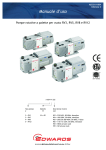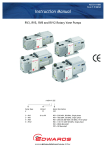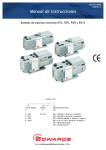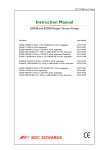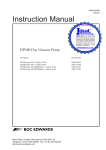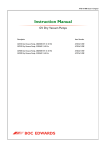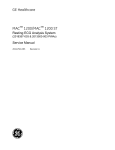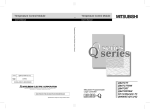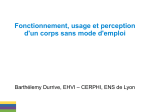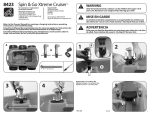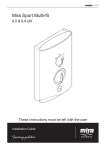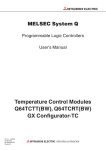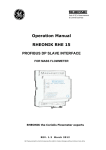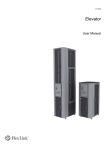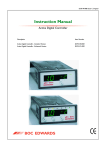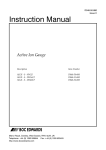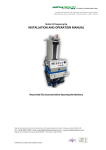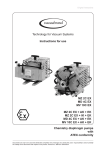Download RV3, RV5, RV8 and RV12 Rotary Vane Pumps
Transcript
User’s Manual General Purpose Rotary Vane Vacuum Pumps Models 1467700 1472100 7739400 7739401 7739402 7739403 A652-01-880 Issue N Instruction Manual RV3, RV5, RV8 and RV12 Rotary Vane Pumps A 65X-YY-ZZZ Pump Type X 2 = RV3 3 = RV5 4 = RV8 5 = RV12 Variant Motor Description YY ZZZ 01 to 99 IPX100 Dry Vacuum Pump Manor Royal, Crawley, West Sussex, RH10 2LW, UK Telephone: +44 (0) 1293 528844 Fax: +44 (0) 1293 533453 http://www.bocedwards.com 903 = 220-240V, 50/60Hz, Single phase 904 = 100/200V, 50/60Hz, Single phase 905 = 200-230/380-460V, 50/60Hz, Three phase 906 = 110-115/120V 50/60Hz, Single phase 965 = NEMA Bareshaft 970 = ISO Bareshaft 1 Declaration of Incorporation We, BOC Edwards, Manor Royal, Crawley, West Sussex, RH10 2LW, UK declare under our sole responsibility that the machine(s) A 65X-YY-ZZZ Pump Type X 2 = RV3 3 = RV5 4 = RV8 5 = RV12 Variant Motor Description YY ZZZ 01 to 99 965 = NEMA Bareshaft 970 = ISO Bareshaft to which this declaration relates is intended to be incorporated into other equipment and not to function independently. The machine(s) is in conformity with the following standard(s) or other normative document(s) EN 292 * EN1012-2 * Safety of Machinery: Basic Concepts, General Principles for Design. Compressors and Vacuum Pumps - Safety Requirements Part 2. Date and Place * When installed according to this instruction manual. This product has been manufactured under a quality system registered to ISO9001 P900-76-000 23.4.99 Shoneham Issue F 2B01-010 The machine(s) must not be put into service until the equipment into which it is incorporated has been brought into conformity with the provisions of the Machinery Directive, 98/37/EC. CONTENTS Section Title Page INTRODUCTION Scope and definitions ATEX directive implications Description Performance modes and controls Mode selector Gas-ballast control Construction 1 1 2 4 4 5 5 5 2 2.1 2.2 2.2.1 2.2.2 2.3 2.3.1 2.3.2 2.4 2.5 2.6 TECHNICAL DATA Operating and storage conditions Performance General Performance characteristics Mechanical data General Noise and vibration data Electrical data: single-phase pumps Electrical data: three-phase pumps Lubrication data 6 6 6 6 10 11 11 11 11 14 14 3 3.1 3.2 3.3 3.4 3.5 3.6 3.6.1 3.6.2 3.6.3 3.7 3.7.1 3.7.2 3.7.3 3.8 3.9 3.10 3.10.1 3.10.2 3.11 INSTALLATION Safety System design considerations Unpack and inspect Locate the pump Fill the pump with oil Electrical installation: single-phase pumps Check and configure the motor Connect the pump to your electrical supply Check the direction of rotation Electrical installation: three-phase pumps Check and configure the motor Connect the pump to your electrical supply Check the direction of rotation Inlet and outlet connections Leak-test the system Electrical installation Check and configure the motor Connect the motor to the electrical supply Check the direction of rotation 15 15 15 16 16 18 18 18 19 21 21 21 22 22 23 24 24 24 24 25 dcs/0169/0503 1 1.1 1.2 1.3 1.4 1.4.1 1.4.2 1.5 RV3, RV5, RV8 and RV12 Rotary Vane Pumps i Section ii Title Page 4 4.1 4.1.1 4.1.2 4.1.3 4.2 4.2.1 4.2.2 4.3 4.4 4.5 4.6 4.7 4.8 OPERATION ATEX directive implications Introduction Flammable/pyrophoric materials Gas purges How to use the pump controls Mode selector Gas-ballast control Start-up procedure To achieve ultimate vacuum To pump condensable vapours To decontaminate the oil Unattended operation Shut-down 26 26 26 26 27 27 28 28 29 29 30 30 31 31 5 5.1 5.2 5.3 5.4 5.5 5.6 5.7 5.8 5.9 5.10 5.11 5.12 5.12.1 5.12.2 32 32 34 35 35 36 36 36 37 37 37 37 37 37 5.12.3 5.12.4 5.12.5 5.12.6 5.12.7 MAINTENANCE Safety information Maintenance plan Check the oil-level Replace the oil Inspect and clean the inlet-filter Inspect and clean the gas-ballast control Clean the oil-level sight-glass Clean the motor fan-cover and enclosure Clean and overhaul the pump Fit new blades Test the motor condition Fault-finding The pump has failed to start The pump has failed to achieve the specified performance (has failed to reach ultimate vacuum) The pump is noisy The pump surface temperature is above 100 °C The vacuum is not fully maintained after the pump is switched off The pumping speed is poor There is an external oil leak 6 6.1 6.2 STORAGE AND DISPOSAL Storage Disposal 40 40 40 7 7.1 7.2 7.3 7.4 7.4.1 SERVICE, SPARES AND ACCESSORIES Introduction Service Spares Accessories Inlet catchpot 42 42 42 43 44 44 38 38 38 39 39 39 RV3, RV5, RV8 and RV12 Rotary Vane Pumps Section Title 7.4.2 7.4.3 7.4.4 7.4.5 7.4.6 7.4.7 7.4.8 7.4.9 7.4.10 7.4.11 7.4.12 7.4.13 Page Inlet dust filter Inlet desiccant trap Inlet chemical trap Solenoid operated gas-ballast valve Foreline trap Solenoid operated pipeline valve Outlet mist filter Gas-ballast adaptor Gravity oil drain kit Vibration isolators Oil drain-extension Exhaust nozzle kit 44 44 44 44 45 45 45 45 45 46 46 46 8 8.1 8.2 8.3 8.4 ROTARY VACUUM PUMP PREPARED FOR USES WITH PFPE OILS Summary Installation Maintenance System Safety 47 47 47 47 47 9 9.1 9.2 BARE SHAFT PUMPS Description Fit the new motor to the pump 48 48 48 Illustrations Figure 1 2 3 4 5 6 7 8 9 10 11 Title The RV pump (single-phase pump shown) Performance characteristics in High Vacuum mode (pumping speed against inlet pressure) Dimensions: mm Motor voltage configuration: single-phase pumps Three-phase electrical connections: 200-230 V Three-phase electrical connections: 380-460 V Inlet-filter assembly Gas-ballast control assembly Sight-glass assembly Accessories Fit the new motor to the pump RV3, RV5, RV8 and RV12 Rotary Vane Pumps Page 3 10 13 17 20 20 32 33 34 41 49 iii Tables Table Title 1 2 3 4 5 6 7 8 Page Technical data (High Vacuum mode) Technical data (High Throughput mode) Performance characteristics Electrical data (single-phase pumps with Item Numbers -903 or -906) Electrical data (single-phase pumps with Item Numbers -904) Electrical data (three-phase pumps with Item Numbers -905) Maintenance plan Spares and Accessories 7 8 9 12 12 14 34 43 Associated publications Publication title Vacuum pump and vacuum system safety iv Publication Number P300-20-000 RV3, RV5, RV8 and RV12 Rotary Vane Pumps 1 INTRODUCTION 1.1 Scope and definitions This manual provides installation, operation and maintenance instructions for the Edwards RV3, RV5, RV8 and RV12 Rotary Vane Pumps. You must use your pump as specified in this manual. Read this manual before you install and operate your pump. Important safety information is highlighted as WARNING and CAUTION instructions; you must obey these instructions. The use of WARNINGS and CAUTIONS is defined below. WARNING Warnings are given where failure to observe the instruction could result in injury or death to people. CAUTION Cautions are given where failure to observe the instruction could result in damage to the equipment, associated equipment and process. The units used throughout this manual conform to the SI international system of units of measurement. In accordance with the recommendations of IEC1010, the following warning symbols are on the pump: Warning - refer to accompanying documents. Warning - risk of electric shock. Warning - hot surface. Warning - risk of catastrophic failure. RV3, RV5, RV8 and RV12 Rotary Vane Pumps 1 1.2 ATEX directive implications ! This equipment is designed to meet the requirements of Group II Category 3 equipment in accordance with Directive 94/9/EC of the European Parliament and the Council of 23rd March 1994 on the approximation of the laws of the Member States concerning equipment and protective systems intended for use in potentially explosive atmospheres. (The ATEX Directive). The ATEX Category 3 applies in respect of potential ignition sources internal to the equipment. An ATEX Category has not been assigned in respect of potential ignition sources on the outside of the equipment as the equipment has not been designed for use where there is an external potentially explosive atmosphere. There is no potential source of ignition within the pump during normal operation but there may be potential sources of ignition under conditions of predicted and rare malfunction as defined in the Directive. Accordingly, although the pump is designed to pump flammable materials and mixtures, operating procedures should ensure that under all normal and reasonably predicted conditions, these materials and mixtures are not within explosive limits. Category 3 is considered appropriate for the avoidance of ignition in the case of a rare malfunction which allows flammable materials or mixtures to pass through the pump while within their explosive limits. ! ! 2 When flammable or pyrophoric materials are present within the equipment you must: ! Not allow air to enter the equipment. ! Ensure that the system is leak tight. ! Use an inert gas purge (for example, a nitrogen purge) to dilute any flammable gases or vapours entering the pump inlet, and/or use an inert gas purge to reduce the concentration of flammable gases or vapours in the pump and in the exhaust pipeline to less than one quarter of the gases' published lower explosive limits (LEL). For further information, please contact BOC Edwards: refer to the Addresses page at the end of this manual for details of your nearest BOC Edwards company. RV3, RV5, RV8 and RV12 Rotary Vane Pumps 1. 2. 3. Electrical inletconnector Voltage indicator Lifting handle (lifting bracket on RV8 and RV12 pumps and Bareshaft) 4. 5. 6. 7. 8. 9. NW25 inlet-port Gas-ballast control Oil filler-plug NW25 outlet-port Oil-level sight-glass Oil drain-plug 10. 11. 12. 13. 14. Rubber feet (4 off) Mode selector On/off switch (singlephase pumps only) Motor fan-cover Correct direction of rotation Figure 1 - The RV pump (single-phase pump shown) RV3, RV5, RV8 and RV12 Rotary Vane Pumps 3 1.3 Description The Edwards RV rotary vane pump is shown in Figure 1. Refer to Figure 1 for item numbers in brackets in the following descriptions. The RV pumps are two-stage, oil-sealed, sliding-vane vacuum pumps. The pump has NW25 inlet (4) and outlet (7) ports, a gas-ballast control (5) and a mode selector (11). When the pump is switched off, an inlet-valve seals the inlet and prevents the suck-back of air and oil into the vacuum system. The RV3 and RV5 pumps have a retractable lifting handle (3). The RV8 and the RV12 pumps are fitted with a lifting bracket for use with suitable lifting equipment. An oil-pump delivers pressurised oil to the vacuum pumping mechanism in the RV pump. You can inspect the level and condition of the oil in the oil-box through a sight-glass (8). Two oil filler-plugs (6) and an oil drain-plug (9) are provided on the oil-box. The pump mechanism is driven directly by a single-phase or three-phase electric motor through a flexible motor-coupling. The motor is totally enclosed and is cooled by the motor cooling-fan which directs air along the motor fins. The pumps are cooled by an additional fan attached to the motor-coupling. Single-phase motors are fitted with an on/off switch (12) and a thermal overload device. When the motor is too hot, the thermal overload device switches off the pump. The thermal overload device has an automatic reset; when the motor cools down, the device resets and (unless you have incorporated suitable control equipment which must be manually reset: see Section 3.6.2), the motor will restart. The pump is mounted on a base plate on rubber feet (10). Details of suitable vibration isolators and other accessories are provided in Section 7. If the pump is prepared for uses with PFPE oils, details are provided in Section 8. 1.4 Performance modes and controls The pump has two controls : the mode selector (11) and the gas-ballast control (5). Six possible combinations of these controls allow for a wide choice of operating characteristics so you can optimize the performance of the pump for a given application. 4 RV3, RV5, RV8 and RV12 Rotary Vane Pumps 1.4.1 Mode selector The mode selector has two positions; refer to Section 4.2 to select these positions. Throughout the rest of this manual, the following convention is used: ! The High Vacuum mode is specified by the " symbol. ! The High Throughput mode is specified by the " symbol. With the mode selector set to High Vacuum mode ", pressurised oil is fed to the low vacuum stage only. In this mode of operation, the pump provides the best possible ultimate vacuum. With the mode selector set to High Throughput mode ", pressurised oil is fed to the high vacuum and low vacuum stages. In this mode of operation, the pump can sustain long-term high inlet pressures. 1.4.2 Gas-ballast control To pump high vapour loads, gas-ballast is delivered into the pump to prevent condensation of the vapour carried by the pumped gases. Air can be introduced to the low vacuum stage through the gas-ballast valve. Alternatively, an inert gas such as nitrogen can be supplied through a suitable external valve. The gas-ballast control has three positions : 1.5 ! Closed (position '0') ! Low flow (position 'I') ! High flow (position 'II'). Construction The pump-shafts and rotors are made of high-grade cast-iron. The pump-body and oil-box are made from cast-aluminium. All surfaces of the pump which are exposed to the pumped gases are free from copper, zinc and cadmium. Other materials of construction include fluorocarbon elastomer, nitrile, silicon, chemicallyresistant polymers, nickel and stainless steel. RV3, RV5, RV8 and RV12 Rotary Vane Pumps 5 2 TECHNICAL DATA 2.1 Operating and storage conditions Ambient temperature range (operation) Normal surface temperature of the pump-body at ultimate vacuum (operation), ambient temperature of 20 °C Maximum humidity (operation) Ambient temperature range (storage) 2.2 Performance 2.2.1 General Note: 50 to 70 °C 90% RH -30 to 70 °C In Tables 1 and 2, total pressures have been measured by a capacitance diaphragm gauge on a vacuum chamber without a cold trap, as specified by Pneurop Standard 6602 (1979). High Vacuum mode " performance High Throughput mode " performance Suckback protection Maximum initial pressure rise with no gas ballast flow Maximum displacement (m3h-1) 50 Hz electrical supply 60 Hz electrical supply Maximum pumping speed (m3h-1) Pneurop 6602 (1979) 50 Hz electrical supply 60 Hz electrical supply Maximum permitted inlet pressure and gas-ballast inlet pressure: bar gauge Pa Maximum permitted outlet pressure: bar gauge Pa 6 12 to 40 °C See Table 1 See Table 2 1 x 10-5 mbar.ls-1, 1 x 10-3 Pa.ls-1 1 x 10-1 mbar.l, 1 x 101 Pa.l RV3 RV5 RV8 RV12 3.7 4.5 5.8 7.0 9.7 11.7 14.2 17.0 3.3 3.9 5.1 6.2 8.5 10.0 12.0 14.2 0.5 0.5 1.5 x 105 1.5 x 105 0.5 0.5 1.5 x 105 1.5 x 105 1 2 x 105 1 2 x 105 1 2 x 105 1 2 x 105 RV3, RV5, RV8 and RV12 Rotary Vane Pumps RV3, RV5, RV8 and RV12 Rotary Vane Pumps 7 mbar Pa Maximum water vapour inlet pressure 3-phase 3-phase 3 x 10-2 3 5 2 x 10-3 2 x 10-1 1-phase RV5 0.22 80 8 x 103 1 x 10-1 1 x 101 14 3-phase 0.04 7 7 x 102 6 x 10-2 6 16 0.06 10 1 x 103 3 x 10-2 3 5 2 x 10-3 2 x 10-1 1-phase RV8 3-phase 0.04 5 5 x 102 6 x 10-2 6 16 0.06 7 7 x 102 3 x 10-2 3 5 2 x 10-3 2 x 10-1 1-phase RV12 0.12 0.22 0.12 0.22 0.20 0.29 0.25 54 50 32 38 34 32 28 3 3 3 3 3 3 5.4 x 10 5.0 x 10 3.2 x 10 3.8 x 10 3.4 x 10 3.2 x 10 2.8 x 103 1.2 x 10-1 1.2 x 101 14 0.06 0.04 0.06 0.04 27 18 16 11 3 3 3 2.7 x 10 1.8 x 10 1.6 x 10 1.1 x 103 3 x 10-2 3 5 2 x 10-3 2 x 10-1 1-phase RV3 Table 1 - Technical data (High Vacuum mode) kg.h-1 Maximum water vapour pumping rate Gas-ballast flow mbar Pa 1.min-1 mbar Pa Maximum water vapour inlet pressure Gas-ballast control high flow (position 'II') Ultimate total pressure kg.h-1 mbar Pa 1.min-1 mbar Pa Units Maximum water vapour pumping rate Gas-ballast flow Gas-ballast control low flow (position 'I') Ultimate total pressure Gas-ballast control closed (position '0') Ultimate total pressure Parameter HIGH VACUUM MODE " 8 RV3, RV5, RV8 and RV12 Rotary Vane Pumps Maximum water vapour pumping rate Maximum water vapour inlet pressure Gas-ballast flow Gas-ballast control high flow (position 'II') Ultimate total pressure Maximum water vapour pumping rate Maximum water vapour inlet pressure Gas-ballast flow Gas-ballast control low flow (position 'I') Ultimate total pressure Gas-ballast control closed (position '0') Ultimate total pressure Parameter 3-phase 3-phase 3 x 10-2 3 1-phase RV5 3-phase 4 x 10-2 4 5 0.06 0.04 10 7 3 1 x 10 7 x 102 3 x 10-2 3 1-phase RV8 3-phase 4 x 10-2 4 5 0.06 0.04 7 5 2 7 x 10 5 x 102 3 x 10-2 3 1-phase RV12 1 x 10-1 1.2 x 10-1 6 x 10-2 6 x 10-2 1 1 6 6 1.2 x 10 1 x 10 16 16 14 14 0.22 0.12 0.22 0.12 0.22 0.20 0.29 0.25 80 54 50 32 38 34 32 28 3 3 3 3 3 3 3 8 x 10 5.4 x 10 5.0 x 10 3.2 x 10 3.8 x 10 3.4 x 10 3.2 x 10 2.8 x 103 6 x 10-2 6 x 10-2 6 6 5 5 0.06 0.04 0.06 0.04 27 18 16 11 3 3 3 2.7 x 10 1.8 x 10 1.6 x 10 1.1 x 103 3 x 10-2 3 1-phase RV3 Table 2 - Technical data (High Throughput mode) kg.h-1 mbar Pa mbar Pa 1.min-1 kg.h-1 mbar Pa mbar Pa 1.min-1 mbar Pa Units HIGH THROUGHPUT MODE " RV3, RV5, RV8 and RV12 Rotary Vane Pumps 9 " High Throughput mode " High Vacuum mode MODE SELECTOR POSITION 2x 10-1 3 Pa Use for continuous inlet pressure above 50 mbar/5 x 103 Pa 3 x 10 -2 mbar Ultimate total pressure Use for the best ultimate pressure 2x 10-3 Pa 3 Pa 0.04 kg.h-1 3-phase pumps 6 (RV3/5) 4 (RV8/12) 6 x 10-2 (RV3/5) 4 x 10-2 (RV8/12) 0.04 kg.h-1 0.06 kg.h-1 Table 3 - Performance characteristics 3-phase pumps 1-phase pumps Maximum water vapour pumping rate Pa mbar Ultimate total presure 0.06 kg.h-1 1-phase pumps Maximum water vapour pumping rate 3x 10-2 mbar Ultimate total presure Ultimate total pressure mbar Low flow (position 'I') Closed (position '0') GAS-BALLAST CONTROL 1.2 x 101 (RV3) 1.0 x 101 (RV5) 6.0 (RV8/12) -1 0.12 kg.h-1 (RV3/5) 0.20 kg.h-1 (RV8) 0.25 kg.h-1 (RV12) 3-phase pumps 1.2 x 101 (RV3) 1.0 x 101 (RV5) 6.0 (RV8/12) -1 3-phase pumps 0.12 kg.h-1 (RV3/5) 0.20 kg.h-1 (RV8) 0.25 kg.h-1 (RV12) 1-phase pumps 0.22 kg.h-1 (RV3/5/8) 0.29 kg.h-1 (RV12) Maximum water vapour pumping rate 1.2 x 10 (RV3) 1.0 x 10-1 (RV5) 6.0 x 10-2 (RV8/12) Pa mbar Ultimate total pressure 0.22 kg.h-1 (RV3/5/8) 0.29 kg.h-1 (RV12) 1-phase pumps Maximum water vapour pumping rate 1.2 x 10 (RV3) 1.0 x 10-1 (RV5) 6.0 x 10-2 (RVB/12) Pa mbar Ultimate total pressure High flow (position 'II') Figure 2 - Performance characteristics in High Vacuum mode (pumping speed against inlet pressure) 2.2.2 Performance characteristics Note: Typical for hydrocarbon oil The following performance characteristics are typical for hydrocarbon oil. The positions of the mode selector and the gas-ballast control define the performance characteristics of the pump. These performance characteristics are listed fully in Tables 1 and 2. Table 3 gives the ultimate vacuum and maximum water vapour inlet pressure for each of the six possible combinations of control positions. The curves 0, I, and II in Figure 2 show the relationship between inlet pressure and pumping speed for High Vacuum mode ". 10 RV3, RV5, RV8 and RV12 Rotary Vane Pumps 2.3 Mechanical data 2.3.1 General Overall dimensions Degree of protection (IEC 34-5: 1981) Maximum tilt angle Motor rotational speed (50 Hz supply) Motor rotational speed (60 Hz supply) Maximum mass, without oil (kg) Maximum mass, Bareshaft pump (kg) 2.3.2 See Figure 3 IP44 (single-phase pumps) IP54 (three-phase pumps) 10 ° 1470 r.min-1 1760 r.min-1 RV3 RV5 RV8 21.6 21.5 26.0 14.0 14.0 16.5 Noise and vibration data Sound pressure, measured at ultimate vacuum 1 metre from the end of the pump to ISO 11201, High Vacuum mode ", 50 Hz operation Vibration severity: measured at the inlet port to ISO 2372 (1974) 2.4 RV12 26.3 17.5 1-phase 3-phase 48 dB (A) 50 dB(A) Class 1C Class 1C Electrical data: single-phase pumps Note: We recommend that you use fuses of the maximum ratings specified in Tables 4 and 5. You must not use fuses of a higher rating. The dual-voltage, dual-frequency motor is designed for a single-phase electrical supply and is suitable for 50 Hz or 60 Hz operation. The motor can be manually switched between nominal supply voltages of 110-120 V and 220-240 V (refer to Section 3.6.1). When you start a cold pump, the motor will draw the start-up current shown in Tables 4 and 5 for up to several seconds, so you must use a slow-blow fuse to prevent unnecessary fuse failure during pump start-up. Within five minutes, as the oil in the pump warms up, the current drawn will slowly reduce to the full load current specified in Tables 4 and 5. RV3, RV5, RV8 and RV12 Rotary Vane Pumps 11 Pump Nominal supply (V) RV3 and RV5 220-240 230-240 110 115-120 50 60 50 60 250 300 250 300 RV8 and RV12 220-240 230-240 110 115-120 50 60 50 60 450 550 450 550 Start-up current Maximum fuse rating (A) 2.4 2.2 4.6 4.4 15.6 15.2 29.4 31.5 5 5 10 10 4.0 3.6 7.8 7.2 18.0 18.0 34.0 34.0 5 5 13 13 Frequency Full load Power (W) (Hz) current (A) Table 4 - Electrical data (single-phase pumps with Item Numbers -903 or -906) Start-up current Maximum fuse rating (A) 2.8 2.4 5.4 4.6 19.4 19.5 37.0 39.0 5 5 10 10 3.9 3.8 7.6 7.6 21.0 20.6 40.0 41.5 5 5 13 13 Full load Frequency Power (W) current (A) (Hz) Pump Nominal supply (V) RV3 and RV5 200 200-210 100 100-105 50 60 50 60 250 300 250 300 RV8 and RV12 200 200-210 100 100-105 50 60 50 60 450 550 450 550 Table 5 - Electrical data (single-phase pumps with Item Numbers -904) Note: 12 The fuse type chosen should be either, time delay type CC or a type M, or in the UK they should be to BS 88. RV3, RV5, RV8 and RV12 Rotary Vane Pumps 1. 2. Pump A RV3 RV5 RV8 RV12 430* 430* 470* 490* A B C D E On/off switch (single-phase pumps only) Lifting bracket (RV8 and RV12 pumps only) and all Bareshaft pumps 429† 429† 469† 489† * Single-phase pumps Top view of single-phase pump Side view of single-phase pump Side view of three-phase pump Front view of single-phase pump Bare shaft pump B C D E F G H I J K 158 158 158 158 225 225 225 225 127 127 161 181 29 29 35 35 78 78 78 78 230 230 230 230 120 120 120 120 37 37 37 37 32 32 32 32 261 261 † Three-phase pumps Figure 3 - Dimensions: mm RV3, RV5, RV8 and RV12 Rotary Vane Pumps 13 2.5 Electrical data: three-phase pumps The dual-voltage, dual-frequency motor is designed for a three-phase electrical supply and is suitable for 50Hz or 60Hz operation. The motor can be manually switched between nominal supply voltages of 220-240v and 380-460v (refer to section 3.7.1). Pumps are supplied pre-set for nominal 380-460v electrical supplies. When you start a cold pump, the motor will draw the start-up current shown in Table 6 for up to 0.5 seconds. The current will then reduce quickly as the motor reaches rated rotational speed. Within 5 minutes, as the oil and pump warms up, the current drawn will slowly reduce to a maximum of the full load current specified in Table 6. When you start a warm pump, the motor will draw the start-up current shown in Table 6 for up to 0.5 seconds. The current drawn will then immediately fall to a maximum of the full load current. Electrical short-circuit and ground-fault protection of the pump will be provided by fitting Class CC fuses of the values shown in Table 6 at the point of connection to the supply. If these are not available in your country of use, Type aM European fuses of the same rating can also be used. Pump Nominal Frequency Power Full load Start-up Recommended supply (V) (Hz) (W) current (A) current (A) fuse rating (A) RV3 and RV5 200-220 200-230 380-415 460 50 60 50 60 250 300 250 300 1.7 1.7 1.0 1.0 10.2 10.2 5.7 7.0 2.5 2.5 2.5 2.5 RV8 and RV12 200-220 200-230 380-415 460 50 60 50 60 450 550 450 550 2.5 2.9 1.5 1.5 14.0 12.0 9.0 8.7 4 4 2.5 2.5 Table 6 - Electrical data (three-phase pumps with Item Numbers -905) 2.6 Lubrication data Note: Edwards Health and Safety Data sheets for rotary pump oils are available on request. Recommended oil* Oil capacity (litres) Maximum Minimum Edwards Ultragrade 19 in hydrocarbon prepared pumps. Krtox 1506 or Fomblin 06/6 in PFPE prepared pumps. RV3 RV5 RV8 RV12 0.70 0.70 0.75 1.00 0.42 0.42 0.45 0.65 * To operate the pump when the ambient temperature is outside the limits specified in Section 2.1, or to optimise the pump performance when you pump condensible vapours, you may need to use a different oil. 14 RV3, RV5, RV8 and RV12 Rotary Vane Pumps 3 INSTALLATION 3.1 Safety WARNING The hydrocarbon prepared RV pump is not recommended for pumping hazardous substances. PFPE prepared pumps are suitable for oxygen applications. Refer to Section 8 You must ensure that the RV pump is suitable for your application. If you have any doubt as to the suitability of the RV pump for your application, refer to the Edwards guidelines on vacuum pump and vacuum system safety (see the Associated publications at the end of the Contents list at the front of this manual). The installation of your RV pump must be performed by a suitably trained and supervised technician. Obey the safety instructions listed below when you install the pump, especially when you connect the pump into an existing system. Details of specific safety precautions are given at the appropriate point in the instructions. 3.2 ! Wear the appropriate safety-clothing when you come into contact with contaminated components. ! Vent and purge your vacuum system before you start installation work. ! Ensure that the installation technician is familiar with the safety procedures which relate to the pump-oil and the products handled by the pumping system. Take suitable precautions to avoid the inhalation of oil mist and excessive skin contact with pump-oil, as prolonged exposure can be harmful. ! Disconnect the other components in the pumping system from the electrical supply so that they cannot be operated accidentally. System design considerations Consider the following points when you design your pumping system: ! Use a suitable valve to isolate the pump from your vacuum system if you need to allow the pump to warm up before you pump condensable vapours, or to provide additional system protection when the pump is switched off. ! Avoid high levels of heat input to the pump from the process gases, otherwise the pump may overheat and seize, and cause the motor thermal overload device to open. ! If you use the pump in a high ambient temperature and have a high gas throughput, the temperature of the pump-body may exceed 70 °C and you must fit suitable guards to prevent contact with hot surfaces. ! Make sure that the exhaust pipeline cannot become blocked. If you have an exhaustisolation valve, make sure that you cannot operate the pump with the valve closed. RV3, RV5, RV8 and RV12 Rotary Vane Pumps 15 ! 3.3 Provide for a purge of inert gas when you shut down the pumping system, to dilute dangerous gases to safe concentrations. A suitable gas ballast adaptor for introduction of purge gas into the pump is available as an accessory (see Section 7.4.9). Unpack and inspect Remove all packing materials, remove the pump from its packing-box, remove the protective covers from the inlet and outlet-ports and inspect the pump. If the pump is damaged, notify your supplier and the carrier in writing within three days; state the Item Number of the pump together with your order number and your supplier's invoice number. Retain all the packing materials for inspection. Do not use the pump if it is damaged. If the pump is not to be used immediately, replace the protective covers. Store the pump in suitable conditions, as described in Section 6.1. 3.4 Locate the pump WARNING Use suitable lifting equipment to move the RV8 or RV12 pump. The mass of the RV8 and RV12 pumps is approximately 26 kg. The RV3 and RV5 pumps have a lifting handle which you can use to move the pump by hand. If you wish to use mechanical lifting equipment, do not attach the equipment to the handle; for stability, use slings around the motor and the pump-body. Do not lift the RV8 and RV12 pumps by hand; attach your mechanical lifting equipment to the lifting bracket on the pump. You do not need to use slings to move the RV8 and RV12 pumps. Provide a firm, level platform for the pump. Locate the pump so that the oil-level sight-glass is visible and the oil filler-plug, oil drain-plug, mode selector and gas-ballast control are accessible. If your pump will be located inside an enclosure, make sure that there is adequate ventilation at both ends of the pump, so that the ambient temperature around the pump does not exceed 40 °C. There must be a minimum space of 25 mm between the pump and the enclosure walls. 16 RV3, RV5, RV8 and RV12 Rotary Vane Pumps A B Top view of motor Internal view of top of motor 1. 2. 3. 4. 5. 6. 7. Cover-plate Electrical inlet-connector Voltage selector switch Voltage indicator On/off switch Position 'O' (off) Position '|' (on) Figure 4 - Motor voltage configuration: single-phase pumps RV3, RV5, RV8 and RV12 Rotary Vane Pumps 17 3.5 Fill the pump with oil WARNING If you use a hydrocarbon prepared pump, you must not use the pump to process oxygen in concentrations greater than 25 % in volume. If you do, there is a risk of fire or explosion in the oil-box of the pump. PFPE prepared pumps are available. Refer to Section 8 Fill the pump with oil as described below. Refer to Section 2 for the recommended oil. Refer to Figure 1 for the item numbers in brackets. 1. Remove one of the oil filler-plugs (6) 2. Pour oil into the pump until the oil-level just reaches the MAX mark on the bezel at the top of the sight-glass (8). If the oil-level goes above the MAX mark, remove the drain-plug (9) and drain the excess oil from the pump. 3. After a few minutes, recheck the oil-level. If the oil-level is now below the MAX mark, pour more oil into the pump. 4. Refit the oil filler-plug. Tighten the plug firmly by hand. Do not overtighten. 3.6 Electrical installation: single-phase pumps Note: 3.6.1 If you have a bare shaft pump read section 9 before continuing. Some parts of Section 3.6 will not be applicable, depending on the type of motor fitted. Check and configure the motor CAUTION Ensure that the motor is correctly configured for your electrical supply. If you operate the pump when the motor is not correctly configured for the electrical supply, you will damage the motor. Refer to Figure 4 for the item numbers in brackets. Ensure that the voltage shown on the voltage indicator (4) in the motor-cover corresponds with your electrical supply voltage. If it does not, you must change the configuration of the pump-motor to match your electrical supply voltage; use the procedure below. 1. Undo the four screws, remove the cover-plate (1) and lift out the voltage indicator moulding (4). 2. Press the voltage selector switch (3) to select the alternative position. 3. Turn the voltage indicator moulding over so that the outer panel shows the required voltage. Refit the moulding. 18 RV3, RV5, RV8 and RV12 Rotary Vane Pumps 4. Refit the cover-plate and secure it with the four screws. 3.6.2 Connect the pump to your electrical supply WARNING Ensure that the electrical installation of the RV pump conforms with your local and national safety requirements. It must be connected to a suitably fused and protected electrical supply and a suitable earth point. Notes: In the UK, if you use a 13 A plug, it must comply with BS1363A and be fitted with a 13 A fuse which complies with BS1362. To prevent automatic restart of the pump-motor if the electrical supply is restored after an electrical supply failure, connect the pump to the electrical supply through suitable control equipment which must be reset manually after an electrical supply failure. Make the electrical connections to the pump-motor with an IEC 320 cable socket (cold condition type) that satisfies your local electrical standards. To maintain compliance with CSA standards, you must only use CSA/UL certified electrical supply cables and connectors. Cables must be SJT rated (minimum) and must incorporate an earth conductor. The conductors in the cable must be a minimum of 18 AWG. If your RV pump was supplied with an electrical supply cable, the cable will be fitted with a moulded IEC connector at one end. The other end of the cable may be fitted with a plug suitable for your local electrical supply. A cable without a plug will contain wires colour coded as follows: Green and yellow Blue Brown earth neutral live 1. Ensure that the on/off switch on the motor (Figure 4, item 5) is in the 'off' position. 2. Insert the moulded IEC connector at the end of the cable into the electrical inlet-connector on the motor (Figure 4, item 2). 3. Connect the plug (if fitted) at the other end of the cable to your electrical supply. If a plug is not fitted, connect the wires in the cable to the correct terminals of your electrical supply. RV3, RV5, RV8 and RV12 Rotary Vane Pumps 19 A B Starter/contactor Motor terminal-box 1. Links Figure 5 - Three-phase electrical connections: 200-230 V A B Starter/contactor Motor terminal-box 1. Links Figure 6 - Three-phase electrical connections: 380-460 V 20 RV3, RV5, RV8 and RV12 Rotary Vane Pumps 3.6.3 Check the direction of rotation CAUTION Ensure that the pump-motor rotates in the correct direction. If it does not, the pump and your vacuum system can become pressurised. Refer to Figure 1 for the item numbers in brackets. 1. Watch the motor cooling-fan through the motor fan-cover (13). 2. Use the on/off switch (12) to switch-on the electrical supply to the motor for a few seconds. 3. Check that the motor cooling-fan rotates in the correct direction (14) shown by the arrow on the motor fan-cover. If the direction of rotation is incorrect, switch off the electrical supply immediately and contact your supplier or Edwards for advice. 3.7 Electrical installation: three-phase pumps 3.7.1 Check and configure the motor CAUTION Ensure that the motor is correctly configured for your electrical supply. If you operate the pump when the motor is not correctly configured for the electrical supply, you will damage the motor. 1. Remove the screws which secure the cover of the motor terminal-box. Remove the cover. 2. Remove the cable-gland from the inside of the terminal-box and fit the cable-gland to the cable leadthrough hole in the side of the terminal-box. 3. Ensure that the motor is correctly configured for your electrical supply. If necessary, reconfigure the links (Figures 5 and 6, item 1) to suit your electrical supply: ! For 200-230 V electrical supplies, the links must be configured as shown in Figure 5. ! For 380-460 V electrical supplies, the links must be configured as shown in Figure 6. RV3, RV5, RV8 and RV12 Rotary Vane Pumps 21 3.7.2 Connect the pump to your electrical supply WARNING Ensure that the electrical installation of the RV pump conforms with your local and national safety requirements. It must be connected to a suitably fused and protected electrical supply and a suitable earth point. Notes: To prevent automatic restart of the pump-motor if the electrical supply is restored after an electrical supply failure, connect the pump to the electrical supply through suitable control equipment which must be reset manually after an electrical supply failure. To maintain compliance with CSA (Canadian Standards Association) standards, you must incorporate a switch or circuit breaker in the pump electrical supply. The switch or circuit breaker must be close to the pump and easily accessible, and must be clearly marked to identify that it is the electrical supply disconnection device for the pump. We recommend that you connect the electrical supply to the motor through a starter or circuit breaker which has thermal over-current protection which can be adjusted to suit the full load current ratings shown in Table 4. The fuse ratings in Table 4 are provided for guidance only. The supplier of your thermal over-current protection device may specify different values to ensure correct operation of the fuse and the over-current protection device. Ensure that the fuse you use is suitable for the starting currents given in Table 4. 1. Pass the electrical supply cable through the cable-gland. The diameter of the electrical supply cable should be in the range 7 to 11 mm. 2. Use insulated crimped connectors to connect the wires in the cable to the terminals U1, V1 and W1 in the terminal-box as shown in Figures 5 and 6. 3. Ensure that the cover gasket is correctly positioned, then refit the cover to the terminalbox and secure with the screws. Tighten the strain-relief nut on the cable-gland. 3.7.3 Check the direction of rotation CAUTION Ensure that the pump-motor rotates in the correct direction. If it does not, the pump and your vacuum system can become pressurised. 1. Refer to Figure 1. Watch the motor cooling-fan through the motor fan-cover (13). 2. Switch-on the electrical supply to the motor for a few seconds. 3. Check that the motor cooling-fan rotates in the correct direction shown by the arrow on the motor mounting plate. If the direction of rotation is incorrect: 22 ! Switch off the electrical supply immediately. ! Isolate the pump from the electrical supply. RV3, RV5, RV8 and RV12 Rotary Vane Pumps 3.8 ! Remove the terminal-box cover and swap wires L1 and L3: see Figures 5 and 6. ! Refit the cover to the terminal-box. Inlet and outlet connections WARNING Connect the exhaust to a suitable treatment plant to prevent the discharge of dangerous gases and vapours to the surrounding atmosphere. Use a catchpot to prevent the drainage of contaminated condensate back into the pump. Before you connect the pump to your vacuum system, fit the centring-ring and inlet-filter (supplied with the pump) to the pump inlet-port (see Figure 5). Take note of the following information when you connect the pump to your vacuum system. Refer to Section 7 for details of the accessories mentioned below. Use standard NW25 fittings (not supplied) when you connect the pump. ! For optimum pumping speeds, ensure that the pipeline connected to the pump-inlet is as short as possible and has an internal diameter of 25 mm or larger. ! Support the vacuum pipelines to prevent loading of the coupling-joints. ! If necessary, incorporate flexible bellows in your system pipelines to reduce the transmission of vibration and to prevent loading of coupling-joints. If you use flexible bellows, you must ensure that you use bellows which have a maximum pressure rating which is greater than the highest pressure that can be generated in your system. We recommend that you use Edwards flexible bellows. ! Use a suitable inlet trap if you pump condensable vapours or if you use the pump for very dusty applications. ! Use a suitable valve to isolate the pump from your vacuum system if you need to pump condensable vapours or maintain vacuum when the pump is switched off. ! Ensure that sealing surfaces are clean and scratch-free. RV3, RV5, RV8 and RV12 Rotary Vane Pumps 23 3.9 Leak-test the system Leak-test the system and seal any leaks found after you have installed the RV pump, to prevent leakage of substances out of the system and leakage of air into the system. 3.10 Electrical installation 3.10.1 Check and configure the motor CAUTION If you operate the pump and the motor is not correctly configured for your electrical supply, you may damage the motor. Before you connect the pump to the electrical supply, check the plug rating plate on the motor and ensure that the motor is suitable for use with your electrical supply. If the motor is multivoltage, ensure that the motor is correctly configured for your electrical supply voltage and frequency; refer to the manufacturers information supplied with the motor. 3.10.2 Connect the motor to the electrical supply WARNING Ensure that the electrical insatllation of the pump conforms with your local and national safety requirements. It must be connected to a suitably fused and protected electrical supply and a suitable earth point. Connect the motor to the electrical supply as specified in the manufacturers information supplied with the motor. Note also the following points;- 24 ! You must use a suitable electrical supply cable. ! Connect the electrical supply to the motor through a starter or circuit breaker which has thermal over current protection which can be set to suit the full load current rating for the motor; refer to the manufacturers information supplied with the motor and to the electrical data in the manual and ensure that the fuse is suitable for the starting current for the motor. ! In the U.K. If the motor is single phase and has built in over current or thermal protection, you may use a 13A plug to connect the motor to the electrical supply. The plug must conform to BS1363A and be fitted with a 13A fuse which complies with BS1362. ! We recomend that you connect the motor to the electrical supply through suitable control equipment which must be reset manually after an electrical supply failure. If you do not the pump will restart when the supply is restored. RV3, RV5, RV8 and RV12 Rotary Vane Pumps 3.11 Check the direction of rotation CAUTION Ensure that the motor rotates in the correct direction. If it does not the pump and vacuum system will be pressurised. Do not connect the pump to the vacuum system when carrying out these tests. 1. Correct direction of rotation is anti clockwise when looking on the motor fan. 2. Watch the motor fan, switch on the supply to the motor for a few seconds, then switch off. 3. If the direction of rotation is incorrect, isolate the motor from the supply and reconfigure the electrical connections to the motor; refer to the manufacturuers information supplied with the motor. 4. Repeat the above check to ensure the direction of rotation is correct. RV3, RV5, RV8 and RV12 Rotary Vane Pumps 25 4 OPERATION 4.1 ATEX directive implications 4.1.1 Introduction This equipment is designed to meet the requirements of Group II Category 3 equipment in accordance with Directive 94/9/EC of the European Parliament and the Council of 23rd March 1994 on the approximation of the laws of the Member States concerning equipment and protective systems intended for use in potentially explosive atmospheres. (The ATEX Directive) The ATEX Category 3 applies in respect of potential ignition sources internal to the equipment. An ATEX Category has not been assigned in respect of potential ignition sources on the outside of the equipment as the equipment has not been designed for use where there is an external potentially explosive atmosphere. There is no potential source of ignition within the pump during normal operation but there may be potential sources of ignition under conditions of predicted and rare malfunction as defined in the Directive. Accordingly, although the pump is designed to pump flammable materials and mixtures, operating procedures should ensure that under all normal and reasonably predicted conditions, these materials and mixtures are not within explosive limits. Category 3 is considered appropriate for the avoidance of ignition in the case of a rare malfunction which allows flammable materials or mixtures to pass through the pump while within their explosive limits. 4.1.2 Flammable/pyrophoric materials WARNING You must obey the instructions and take note of the precautions given below, to ensure that pumped gases do not enter their flammable ranges. When flammable or pyrophoric materials are present within the equipment you must: 26 ! Not allow air to enter the equipment. ! Ensure the system is leak tight. ! Use an inert gas purge (for example, a nitrogen purge) to dilute any flammable gases or vapours entering the pump inlet, and/or use an inert gas purge to reduce the concentration of flammable gases or vapours in the pump and in the exhaust pipeline to less than one quarter of the gases' published lower explosive limits (LEL). ! Use an inert gas purge in to the pump gas ballast connection to prevent the condensation of flammable vapours within the pump mechanism and exhaust pipeline. RV3, RV5, RV8 and RV12 Rotary Vane Pumps 4.1.3 Gas purges WARNING If you use inert gas purges to dilute dangerous gases to a safe level, ensure that the RV3, RV5, RV8 and RV12 rotary vane pump is shut down if an inert gas supply fails. WARNING You must obey the instructions and take note of the precautions given below, to ensure that pumped gases do not enter their flammable ranges. Switch on the inert gas purge to remove air from the pump and the exhaust pipeline before the process starts. Switch off the purge flow at the end of the process only after any remaining flammable gases or vapours have been purged from the pump and exhaust pipeline. If liquids that produce flammable vapours could be present in the pump foreline, then the inert gas purge to the RV3, RV5, RV8 and RV12 rotary vane pump should be left on all the time this liquid is present. Flammable liquids could be present in the foreline as a result of condensation, or may be carried over from the process. When you calculate the flow rate of inert gas required for dilution, consider the maximum flow rate for the flammable gases/vapours that could occur. For example, if a mass flow controller is used to supply flammable gases to the process, you should assume a flow rate for flammable gases that could arise if the mass flow controller is fully open. Continually measure the inert gas purge flow rate: if the flow rate falls below that required, you must stop the flow of flammable gases or vapours into the pump. Note: 4.2 We recommend that you obtain and read the Vacuum Pump and Vacuum System Safety manual (publication number P300-20-000), available from BOC Edwards or your supplier. How to use the pump controls You can use the mode selector (Figure 1, item 11) and the gas-ballast control (Figure 1, item 5) to optimise the performance of the RV pump for your application. The performance characteristics of the pump with the different control settings are shown in Tables 1 and 2. You can change the position of both the mode selector and the gas-ballast control when the pump is off or when the pump is operating. RV3, RV5, RV8 and RV12 Rotary Vane Pumps 27 4.2.1 Mode selector Note: The pump is supplied with High Vacuum mode " selected. If High Vacuum mode is selected and you cannot turn the mode selector by hand to select the High Throughput mode, use a suitable tool fitted to the flat part of the mode selector to turn the selector. The mode selector controls the flow of pressurised oil to the high vacuum stage of the pump (see Section 1.4.1). You can turn the mode selector to one of two positions, as follows: To select the High Vacuum mode ", turn the mode selector fully clockwise and tighten by hand. When High Vacuum mode is selected, there is a gap of approximately 3 mm between the mode selector and the inner face of the side panel of the pump. Use this mode: ! to achieve ultimate vacuum ! to pump clean gases ! to pump clean condensable vapours. To select the High Throughput mode ", turn the mode selector fully anticlockwise until it touches the inner face of the side panel of the pump, then gently tighten by hand. Use this mode: 4.2.2 ! for long-term operation with high gas throughput (that is, inlet pressure > 50 mbar) ! to pump dirty condensable vapours ! to decontaminate the oil. Gas-ballast control Use the gas-ballast control to change the amount of air (or inert gas) introduced into the low vacuum stage of the pump (refer to Section 1.4.2). Use of gas-ballast will prevent the condensation of vapours in the pump; the condensates would contaminate the oil. You can turn the gas-ballast control to select one of three positions, as follows: To select gas-ballast closed, turn the control to position '0'. Use this setting: ! to achieve ultimate vacuum ! to pump dry gases. To select low flow gas-ballast, turn the control to position 'I'. Use this setting: 28 ! to pump low concentrations of condensable vapours ! to decontaminate the oil. RV3, RV5, RV8 and RV12 Rotary Vane Pumps To select high flow gas-ballast, turn the control to position 'II'. Use this setting: ! to pump high concentrations of condensable vapours. When you use either low flow or high flow gas-ballast, there will be an increased rate of oil loss from the pump. Where possible, we recommend that you select low flow gas-ballast (position 'I') rather than high flow gas-ballast (position 'II') to minimise the loss of oil. 4.3 Start-up procedure WARNING Ensure that your system design does not allow the exhaust pipeline to be blocked. If the oil is contaminated, or if the pump temperature is below 12 °C, or if the electrical supply voltage is more than 10% below the lowest voltage specified on the voltage indicator (Figure 4, item 4), the pump may operate at a reduced speed for a few minutes. On single-phase pumps, if the pump continues to operate at reduced speed, the motor thermal overload device will open and stop the pump. When the motor has cooled, the thermal overload device will reset automatically and the pump will restart. 1. Check that the pump oil-level is between the MAX and MIN marks on the bezel of the oillevel sight-glass; if it is not, refer to Section 5.3. 2. Turn the mode selector fully clockwise to select High Vacuum mode " or fully anticlockwise to select High Throughput mode ", as required (refer to Section 4.2.1). 3. Turn the gas-ballast control to position '0', 'I' or 'II', as required (refer to Section 4.2.2). 4. Switch on the electrical supply to the pump; on single-phase pumps, use the on/off switch. 5. If you want to achieve ultimate vacuum, to pump condensable vapours or to decontaminate the pump oil, refer to the procedures in Sections 4.4, 4.5 and 4.6 respectively. Otherwise, open the vacuum system isolation-valve. 4.4 To achieve ultimate vacuum If the pump does not achieve the performance specified in Section 2, make sure that this is not due to your system design before you contact your supplier or Edwards for advice. In particular, the vapour pressure of all materials used in your vacuum system (including pump oil, see below) must be much lower than the specified ultimate vacuum of the pump. Refer to Section 5.12.2 for a list of possible causes for failure to achieve the specified performance; note however that the most common causes are: ! Your pressure measurement technique or gauge head is unsuitable or the gauge head is faulty. ! You have used an oil other than the recommended oil, and the vapour pressure of the oil is higher than the specified ultimate vacuum of the pump. RV3, RV5, RV8 and RV12 Rotary Vane Pumps 29 Use the following procedure to achieve ultimate vacuum: 1. Isolate the RV pump from your vacuum system. 2. Turn the mode selector to select High Throughput mode ", set the gas-ballast control to low flow (position 'I') and operate the pump for at least 1 hour (or overnight) to thoroughly purge the oil of contaminants. 3. Turn the mode selector to select High Vacuum mode " and close the gas-ballast control (that is, set it to position '0'). 4. Open the vacuum system isolation-valve and pump down to ultimate vacuum. 4.5 To pump condensable vapours Use gas-ballast (gas-ballast control in position 'I' or 'II') when there is a high proportion of condensable vapours in the process gases. 1. Close the vacuum system isolation-valve. 2. Turn the mode selector fully clockwise to select High Vacuum mode " or fully anticlockwise to select High Throughput mode ", as required (refer to Section 4.2.1). 3. Turn the gas-ballast control to high flow (position 'II') and operate the pump for 30 minutes to warm the oil; this will help to prevent vapour condensation in the pump. 4. Set the gas-ballast control to the position required for your application (refer to Section 4.2.2 and the data in Tables 1 and 2). 5. Open the vacuum system isolation-valve. After you have pumped condensable vapours, you can (if necessary) decontaminate the oil: use the procedure in Section 4.6. 4.6 To decontaminate the oil The oil in the pump should be clear; if the oil is cloudy or discoloured, it is contaminated with process vapours. 1. Look at the condition of the oil in the oil-level sight-glass (Figure 1, item 8). If the oil is cloudy or discoloured, continue with the procedure at Step 2 below. 2. Close the vacuum system isolation-valve. 3. Turn the mode selector fully anticlockwise to select High Throughput mode ". Set the gas-ballast control to low flow (position 'I'). 4. Operate the pump until the oil is clear. 30 RV3, RV5, RV8 and RV12 Rotary Vane Pumps 4.7 Unattended operation The RV pump is designed for unattended operation under the normal operating conditions specified in Section 2. However, we recommend that you check the pump at regular intervals of not more than 14 days, or more frequently if you pump high volumes of gas or vapour. On single-phase pumps, the motor is protected by an overload device which isolates the pump from the electrical supply when critical temperature or current levels are exceeded. The overload device resets automatically when the motor has cooled. When you check the pump, make sure that the pump is not going through a repetitive cycle of thermal overload failures and automatic resets. If necessary, change the mode selector to High Throughput mode " and reduce the thermal load from the pumped gases, to prevent overheating of the pump. 4.8 Shut-down We recommend, as described in the procedure below, that you decontaminate the oil before you shut down the pump; this will prevent damage to the pump by the contaminates in the oil. 1. Refer to Section 4.6 and decontaminate the oil, as required. 2. Close the vacuum system isolation-valve (if not already closed). 3. Close gas-ballast (that is, set the gas-ballast control to position '0'). 4. On single-phase pumps, use the on/off switch to switch off the pump. 5. Switch off the electrical supply to the pump. RV3, RV5, RV8 and RV12 Rotary Vane Pumps 31 5 MAINTENANCE 5.1 Safety information WARNING Obey the safety instructions given below and take note of appropriate precautions. If you do not, you can cause injury to people and damage to equipment. ! If your pump is PFPE prepared, refer to Section 8. ! Ensure that maintenance is done by a suitably trained and supervised technician. Obey your local and national safety requirements. ! Ensure that the maintenance technician is familiar with the safety procedures which relate to the pump-oil and the products processed by the pumping system. ! Check that all the required parts are available and of the correct type before you start work. ! Isolate the pump and other components from the electrical supply so that they cannot be operated accidentally. ! Allow the pump to cool (so that it is at a safe temperature for skin contact) before you start maintenance work. Make sure the pump is switched off in case the thermal overload device restarts the pump. ! Do not reuse 'O' rings and seals if they are damaged. ! After maintenance is completed, recheck the direction of pump rotation if the electrical supply has been disconnected. ! The pump and the pump-oil will be contaminated with the process chemicals that have been pumped during operation. Ensure that the pump is decontaminated before maintenance and that you take adequate precautions to protect people from the effects of dangerous substances if contamination has occurred. 1. 2. 3. Centring-ring and filter assembly 'O' ring Inlet-port Figure 7 - Inlet-filter assembly 32 RV3, RV5, RV8 and RV12 Rotary Vane Pumps 1. 2. 3. 4. 5. 6. 7. ! Do not touch or inhale the thermal breakdown products of fluorinated materials which may be present if the pump has been heated to 310 °C and above. Fluorinated materials are safe in normal use but can decompose into very dangerous substances (which may include hydrofluoric acid) if they are heated to 310 °C and above. The pump may have overheated if it was misused or if it was in a fire. Health and Safety Data sheets for fluorinated materials used in the pump are available on request: contact your supplier or Edwards. ! If neccessary, maintain the motor as specified in the manufacturers information supplied with the motor. Gas-ballast control 'O' ring Air-hole 'O' ring Bayonet-lugs Compression spring Filter element Figure 8 - Gas-ballast control assembly RV3, RV5, RV8 and RV12 Rotary Vane Pumps 33 5.2 Maintenance plan The plan shown in Table 7 details the routine maintenance operations necessary to maintain RV pumps in normal use. Instructions for each operation are given in the section shown. Operation Check the oil-level Replace the oil Inspect and clean the inlet-filter Inspect and clean the gas-ballast control Clean the oil-level sight-glass Clean the motor fan-cover and enclosure Clean and overhaul the pump Fit new blades Test the motor condition Frequency Refer to Section Monthly Every 3000 hours Yearly Yearly Yearly Yearly Every 15000 hours Every 30000 hours Every 15000 hours 5.3 5.4 5.5 5.6 5.7 5.8 5.9 5.10 5.11 Table 7 - Maintenance plan 1. 2. 3. 4. 5. Screws (2 off M6 x 20) Bezel Sight-glass 'O' ring Oil-box Figure 9 - Sight-glass assembly 34 RV3, RV5, RV8 and RV12 Rotary Vane Pumps More frequent maintenance may be required if the pump is used to pump corrosive or abrasive gases and vapours, such as solvents, organic substances and acids; in these circumstances, we recommend that you replace the pump seals every year (refer to Section 7 for details of available spares). If necessary, adjust the maintenance plan according to your experience. When you maintain the RV pump, use Edwards spares and maintenance kits; these contain all of the components necessary to complete maintenance operations successfully. The Item Numbers of the spares and kits are given in Section 7. 5.3 Check the oil-level Note: If required, you can check the oil-level while the pump is operating, however you must switch off the pump and isolate the pump and other components in the pumping system from the electrical supply before you pour oil into the pump. Refer to Figure 1 for the items in brackets. 1. Check that the oil-level in the sight-glass (8) is between the MAX and MIN level marks on the bezel of the sight-glass. 2. If the oil-level is near to or below the MIN level mark, remove one of the filler-plugs (6) and pour more oil into the reservoir until the oil reaches the MAX level mark. If the oillevel goes above the MAX mark, remove the drain-plug (9) and drain the excess oil from the pump. Refit the filler-plug. 3. If the oil is contaminated, drain and refill the pump with clean oil as described in Section 5.4. 5.4 Replace the oil 1. Refer to Figure 1. Operate the pump for approximately ten minutes to warm the oil, then switch off the pump (this lowers the viscosity of the oil and enables it to be drained from the pump more easily). 2. Isolate the pump from your electrical supply and disconnect it from your vacuum system. 3. Remove one of the oil filler-plugs (6). 4. Place a suitable block under the pump-motor to tilt the pump and place a suitable container under the drain-plug (9). Remove the drain-plug and allow the oil to drain into the container. 5. If the oil drained from the pump is contaminated, pour clean oil into the filler-hole and allow it to drain out of the pump. Repeat this step until the oil reservoir in the pump has been thoroughly cleaned. 6. Refit the drain-plug, remove the block and reconnect the pump to your vacuum system. 7. Fill a suitable container with clean oil and pour the oil into the filler hole until the oil-level reaches the MAX level mark on the bezel of the sight-glass (8). 8. Allow a few minutes for the oil to drain into the pump. If necessary, add more oil. Refit the filler-plug. RV3, RV5, RV8 and RV12 Rotary Vane Pumps 35 5.5 Inspect and clean the inlet-filter 1. Refer to Figure 8. Disconnect your vacuum system from the pump inlet-port (3) and remove the centring-ring and filter assembly (1) and the 'O' ring (2). Inspect the centringring and the 'O' ring. If they are clean, continue at Step 5. If they are not clean, continue at Step 2. 2. Remove the 'O' ring (2) from the centring-ring and filter assembly (1). Do not allow the 'O' ring to come into contact with the cleaning solution. 3. Wash the centring-ring and filter assembly in a suitable cleaning solution and allow it to dry. 4. If necessary, wipe the 'O' ring with a clean, dry, lint-free cloth. 5. Refit the centring-ring and filter assembly and the 'O' ring to the inlet-port. Refit your vacuum system to the pump inlet-port. 5.6 Inspect and clean the gas-ballast control Note: The gas-ballast filter element (Figure 8, item 7) is retained in its seating with adhesive; do not try to remove it. 1. Refer to Figure 8. Turn the gas-ballast control (1) to the high flow position (position 'II'). 2. Push the control down against the compression spring (6) as far as it will go, then turn the control anticlockwise slightly to release the bayonet-lugs (5) and remove the control. 3. If necessary, wipe the control with a clean, dry, lint-free cloth and check that the air-hole (3) is not blocked. 4. Refit the control into the gas-ballast inlet and ensure that the compression spring locates correctly between the bayonet-lugs. 5. Push the control down as far as it will go and then turn the control clockwise slightly until the bayonet-lugs engage correctly. 6. Reset the gas-ballast control to the required position. 5.7 Clean the oil-level sight-glass Refer to Figure 9 for the item numbers in brackets. 1. Drain the oil as described in Section 5.4. 2. Undo the two screws (1) and remove the bezel (2), the sight-glass (3) and the 'O' ring (4) from the oil-box (5). 3. Clean the screws, bezel and sight-glass with a suitable cleaning solution. 4. Wipe the 'O' ring with a clean, dry, lint-free cloth. 5. Wipe the sight-glass recess in the oil-box with the cloth. 36 RV3, RV5, RV8 and RV12 Rotary Vane Pumps 6. Refit the 'O' ring, sight-glass and bezel and secure with the two screws. 7. Refill the pump with oil as described in Section 5.4. 8. Check that the sight-glass does not leak. 5.8 Clean the motor fan-cover and enclosure If the motor fan-cover and enclosure are not kept clean, the air-flow over the motor can be restricted and the pump may overheat. 1. Switch off the pump and disconnect it from the electrical supply. 2. Use a dry cloth and a soft brush to remove dirt and deposits from the fan-cover and enclosure. 5.9 Clean and overhaul the pump Clean and overhaul the pump as described in the instructions supplied with the clean and overhaul kit (see Section 7). 5.10 Fit new blades Fit new blades to the pump as described in the instructions supplied with the blade kit (see Section 7). 5.11 Test the motor condition Test the earth continuity and the insulation resistance of the pump-motor, in accordance with local regulations for periodic testing of electrical equipment. The motor of single-phase RV pumps complies with IEC 1010-1. We recommend that, to maintain compliance with IEC 1010-1, the earth continuity is less than 0.1 W and the insulation resistance is greater than 10 MW. If the motor fails these tests, you must replace the motor. 5.12 Fault-finding A list of fault conditions and their possible causes is provided here to assist you in fault-finding. If you are unable to rectify a fault when you use this guide, call your nearest Edwards Service Centre for help. 5.12.1 The pump has failed to start ! The electrical supply fuse has blown RV3, RV5, RV8 and RV12 Rotary Vane Pumps 37 5.12.2 5.12.3 5.12.4 ! The electrical supply voltage does not match that of the motor ! The outlet pipeline or the outlet-filter (if fitted) is blocked ! The oil temperature is below 12 °C ! The oil is too viscous ! The oil is contaminated ! The pump has seized after long storage ! The pump has been left to stand after contaminants have been pumped and has seized ! The motor is faulty. The pump has failed to achieve the specified performance (has failed to reach ultimate vacuum) ! Your pressure measurement technique or gauge head is unsuitable or gives an incorrect indication of pressure. For example, a contaminated Pirani gauge can indicate a pressure which is several times higher than the actual pressure in the system. ! You have filled the pump with the wrong type of oil ! There is a leak in your vacuum system ! The mode selector and gas-ballast control are set incorrectly ! The oil-level is below minimum level ! The oil is contaminated ! Your vacuum fittings are dirty or damaged ! The inlet-filter is blocked ! The pump has not warmed up. The pump is noisy ! The motor fan-cover is damaged ! The motor bearings are worn ! The oil is contaminated with solid particles. The pump surface temperature is above 100 °C Note: ! 38 If the inlet pressure is continuously higher than 100 mbar (1 x 104 Pa), the surface temperature of the RV12 pump can reach 115 °C when the ambient temperature is 40 °C. The ambient temperature is too high RV3, RV5, RV8 and RV12 Rotary Vane Pumps 5.12.5 5.12.6 5.12.7 ! The cooling-air supply is insufficient or is too hot ! The electrical supply voltage is too high ! The outlet-filter or the outlet pipeline is blocked ! The oil-level is below minimum level ! You have filled the pump with the wrong type of oil ! The oil is contaminated ! The process gas is too hot or the throughput is too high. The vacuum is not fully maintained after the pump is switched off ! The gas-ballast control is open (that is, in position 'I' or 'II') ! The inlet valve-pad is damaged ! The inlet valve has not closed. The pumping speed is poor ! The connecting pipelines are too small in diameter ! The connecting pipelines are too long ! The inlet-filter is blocked. There is an external oil leak ! The outer shaft-seal is worn or damaged ! The oil-box gaskets have deteriorated ! There is an oil leak from the gas-ballast control ! There is an oil leak from the drain-plug ! There is an oil leak from the sight-glass RV3, RV5, RV8 and RV12 Rotary Vane Pumps 39 6 STORAGE AND DISPOSAL 6.1 Storage CAUTION Observe the storage temperature limits stated in Section 2. Storage below -30 °C will permanently damage the pump seals. Note: If you will store a new pump in conditions of high humidity, remove the pump from its cardboard packaging box; dispose of the box (refer to Section 6.2). Use the following procedure to store the pump: 1. Shut-down the pump as described in Section 4. 2. Disconnect the pump from the electrical supply. 3. Purge your vacuum system and the pump with dry nitrogen and disconnect the pump from your vacuum system. 4. Replace the oil as described in Section 5.4. 5. Place and secure protective covers over the inlet and outlet-ports. 6. Store the pump in cool, dry conditions until required for use. When required, prepare and install the pump as described in Section 3. If the pump has been stored for more than a year, before you install the pump you must clean and overhaul it as described in the instructions supplied with the clean and overhaul kit. 6.2 Disposal Dispose of the pump and any components removed from it safely in accordance with all local and national safety and environmental requirements. Particular care must be taken with components and waste oil which have been contaminated with dangerous process substances. Do not incinerate fluoroelastomer seals and 'O' rings. 40 RV3, RV5, RV8 and RV12 Rotary Vane Pumps 1. 2. 3. 4. 5. 6. Inlet catchpot Inlet dust filter Inlet desiccant trap Inlet chemical trap Solenoid operated gas-ballast valve Foreline trap 7. 8. 9. 10. 11. 12. Solenoid operated pipeline valve Outlet mist filter Gas-ballast adaptor Gravity oil drain kit Vibration isolators Oil drain-extension Figure 10 - Accessories RV3, RV5, RV8 and RV12 Rotary Vane Pumps 41 7 SERVICE, SPARES AND ACCESSORIES 7.1 Introduction Edwards products, spares and accessories are available from Edwards companies in Belgium, Brazil, Canada, France, Germany, Hong Kong, Italy, Japan, Korea, Switzerland, United Kingdom, U.S.A and a world-wide network of distributors. The majority of these centres employ Service Engineers who have undergone comprehensive Edwards training courses. Order spare parts and accessories from your nearest Edwards company or distributor. When you order, state for each part required: 7.2 ! Model and Item Number of your equipment ! Serial number ! Item Number and description of part. Service Edwards products are supported by a world-wide network of Edwards Service Centres. Each Service Centre offers a wide range of options including: equipment decontamination; service exchange; repair; rebuild and testing to factory specifications. Equipment which has been serviced, repaired or rebuilt is returned with a full warranty. Your local Service Centre can also provide Edwards engineers to support on-site maintenance, service or repair of your equipment. For more information about service options, contact your nearest Service Centre or other Edwards company. 42 RV3, RV5, RV8 and RV12 Rotary Vane Pumps 7.3 Spares Hydrocarbon Variants Part Number PFPE Variants Part Number Edwards oil 1L Ultragrade 19 H110-25-015 (1kg) Fomblin 06/6 H113-06-019 Edwards oil 4L Ultragrade 19 H110-25-013 (5kg) Fomblin 06/6 H113-06-020 Clean and overhaul kit (Standard) A652-01-131 A652-01-131 RV3 Blade kit A652-01-130 A652-01-130 RV5 Blade kit A653-01-130 A653-01-130 RV8 Blade kit A654-01-130 A654-01-130 RV12 Blade kit A655-01-130 A655-01-130 RV3 Cartridge Kit A652-01-032 A652-09-032 RV5 Cartridge Kit A653-01-032 A653-09-032 RV8 Cartridge Kit A654-01-032 A654-09-032 RV12 Cartridge Kit A655-01-032 A655-09-032 Inlet-valve kit A652-01-036 A652-01-036 Motor Starting Relay Kit A505-74-000 A505-74-000 Outer Shaft-Seal Kit A652-01-134 A652-01-134 Rotor Sleeve Kit A652-01-136 A652-09-136 RV3/RV5 Motor Kit (Europe/USA) 50/60 Hz, 250/300 W, 1 phase, 110-120/220-240 V A652-99-000 A652-99-000 RV8/RV12Motor Kit (Europe/USA) 50/60 Hz, 450/550 W, 1 phase, 110-120/220-240 V A654-99-000 A654-99-000 RV3/RV5 Motor Kit (Japan) 50/60 Hz, 250/300 W, 1 phase, 100/200 V A652-98-000 A652-98-000 RV8/RV12 Motor Kit (Japan) 50/60 Hz, 450/550 W, 1 phase, 100/200 V A654-98-000 A654-98-000 RV3/RV5 Motor Kit (Europe/USA/Japan 50/60 Hz, 250/300 W, 3 phase, 200-230/380-460 V A652-97-000 A652-97-000 RV8/RV12 Motor Kit (Europe/USA/Japan) 50/60 Hz, 450/550 W, 3 phase, 200-230/380-460 V A654-97-000 A654-97-000 Clean and Overhaul Kit (Nitrile) A652-01-137 Product Table 8 - Spares and Accessories RV3, RV5, RV8 and RV12 Rotary Vane Pumps 43 7.4 Accessories Figure 11 shows the accessories which can be fitted to an RV pump. 7.4.1 Inlet catchpot The inlet catchpot traps any liquid droplets and prevents their entry into the pump. Product ITO20K Inlet catchpot 7.4.2 Item Number A441-10-000 Inlet dust filter The inlet dust filter protects the pump against abrasive dust. Product ITF20K Inlet dust filter 7.4.3 Item Number A442-15-000 Inlet desiccant trap Use a desiccant trap when you pump limited quantities of water vapour at high pumping speeds to a low vapour pressure. Product ITD20K Inlet desiccant trap 7.4.4 Item Number A445-10-000 Inlet chemical trap The inlet chemical trap protects the pump against chemically active gases. Product ITC20K Inlet chemical trap 7.4.5 Item Number A444-10-000 Solenoid operated gas-ballast valve Fit the gas-ballast valve in place of the built-in gas-ballast control on the pump; you must fit the gas-ballast adaptor (see Section 7.4.9) with the solenoid operated gas-ballast valve. The valve provides automatic on/off control of the gas-ballast and isolates the gas-ballast inlet when the pump is switched off. Product EBV20 Valve EBV20 Valve 44 Electrical supply 220-240 V 50/60 Hz 100-120 V 50/60 Hz Item Number A500-06-930 A500-06-984 RV3, RV5, RV8 and RV12 Rotary Vane Pumps 7.4.6 Foreline trap Use a foreline trap on a clean pumping system to prevent back-migration of pump-oil vapour into your vacuum system. Product FL20K Foreline trap 7.4.7 Item Number A133-05-000 Solenoid operated pipeline valve Fit the pipeline valve between your vacuum system and the pump-inlet to provide additional system protection when the pump is switched off. 7.4.8 Product Electrical supply PV25EK Valve PV25EK Valve 220-240 V 50/60 Hz 110-127 V 50/60 Hz Item Number Aluminium Stainless steel C413-01-000 C413-02-000 C413-03-000 C413-04-000 Outlet mist filter The outlet mist filter separates and traps oil droplets in the pump outlet to prevent oil mist discharge. Product EMF10 Outlet mist filter EMF20 Outlet mist filter 7.4.9 Item Number A462-26-000 A462-29-000 Gas-ballast adaptor Fit the gas-ballast adaptor in place of the gas-ballast control on the pump. The adaptor allows you to fit a solenoid operated gas-ballast valve or a controlled supply of inert gas to the pump. Product Gas-ballast adaptor 7.4.10 Item Number A505-02-000 Gravity oil drain kit Fit the oil drain kit between the drain port of the outlet mist filter and the oil filler-plug on the pump. When the kit is fitted, oil will be returned from the mist filter to the pump when the pump is switched off or when the gas-ballast control is closed (in the '0' position) and there is no process gas being pumped. Product Gravity oil drain kit RV3, RV5, RV8 and RV12 Rotary Vane Pumps Item Number A505-01-000 45 7.4.11 Vibration isolators Vibration isolators reduce vibration and noise when the pump is floor or frame mounted and help to reduce strain when the mounting area is uneven. Product Vibration isolators (pack of four) 7.4.12 Item Number A248-01-404 Oil drain-extension Fit the oil drain-extension between the oil drain port on the pump and the oil drain-plug to make the drainage of oil from the pump easier. Product Oil drain-extension 7.4.13 Item Number A505-03-000 Exhaust nozzle kit The exhaust nozzle replaces the outlet flange. Use the exhaust nozzle to connect the pump outlet to 12 mm internal diameter plastic hose. Product Exhaust nozzle kit 46 Item Number A505-09-000 RV3, RV5, RV8 and RV12 Rotary Vane Pumps 8 ROTARY VACUUM PUMP PREPARED FOR USES WITH PFPE OILS 8.1 Summary WARNING PFPE prepared pumps allow pumping of high concentrates of oxygen, but are not recommended for pumping hazardous materials. The pump is prepared for use with BOC Edwards PFPE mechanical pump oils, (such as Fomblin YVAC 06/6 and Krytox 1506) and is intended for use when pumping high concentrates of oxygen. CAUTION Never use hydrocarbon lubricants in a PFPE prepared pump. 8.2 Installation When you fill the pump with oil, use a suitable BOC Edwards PFPE oil. Ignore any further mention of BOC Edwards Oils stated in this manual. 8.3 Maintenance WARNING Do not touch the thermal breakdown products of fluorinated materials which may PFPE present if the pump has been heated to 260 °C and above. These breakdown products are very dangerous. Fluorinated materials in the pump include the seals, the RT15 grease and your oil. CAUTION Care must be taken after a pump malfunction, in case the oil has been overheated. Note! Fomblin oil is difficult to seal, and it is advised that a regular check must be performed for oil leaks, especially round shaft seals. 8.4 System Safety Refer to EHVI Publication No P300-20-0000. (Vacuum Pump & Vacuum System Safety) RV3, RV5, RV8 and RV12 Rotary Vane Pumps 47 9 BARE SHAFT PUMPS 9.1 Description Two types of bare shaft pump are available;! To suit an IEC72-1 motor with an (IMB14) FT85 face mounting and 14 mm diameter shaft. ! To suit a NEMA 56C motor with a 5/8" diameter shaft. The new motor must have an adequate power rating for use with the RV pump, refer to the pump electrical data section in the manual. Note: 9.2 Some of the standard performance specifications may vary, depending on the type of motor fitted. Fit the new motor to the pump Refer to Figure 11. Use the four screws (455) to fit the motor support (453) to the motor. Use the two screws (422) to fit the lifting plate (413), then fit the lifting plate cover (414). Fit the fan ducting sheet (409). Ensure that key "B" is in place on the motor shaft, then push the fan (410) onto the shaft. Ensure that the end of the shaft aligns with the bottom of the cavity in the fan and that the back of the fan is 2,5 mm from the ducting sheet. Secure the fan to the shaft with the screw (454). Tighten the screw to a torque between 7 and 9 Nm. Use a suitable lubricant on the coupling element (411) then fit the element to the coupling hub. Align the coupling element in the hub with the coupling in the fan and fit the motor to the pump. Secure the motor with the four screws (421). Tighten the screws to a torque of between 10 and 12 Nm. The gap between the coupling faces must be 2 mm or less; adjust the position of the coupling hub on the pump shaft to acheive this dimension. 48 RV3, RV5, RV8 and RV12 Rotary Vane Pumps # Shown for reference only A B Pump motor Key (in shaft) 132 Coupling hub 409 Ducting sheet 410 411 413 414 421 454 453 455 Fan Coupling element Lifting plate Lifting plate cover Screw Screw Motor support Screw Figure 11 - Fit the new motor to the pump In any of the following circumstances, we recommend that you fit an oil mist filter to the pump outlet: ! If you use the pump with the gas ballast control open (in position 'I' or position 'II'). ! If you operate the pump with an inlet pressure greater than 10 mbar (1 x 103 Pa) for extended periods. ! If you frequently pump down from atmospheric pressure. The oil mist filter will trap the oil exhausted from the pump; you can reuse the oil if it is not contaminated. RV3, RV5, RV8 and RV12 Rotary Vane Pumps 49 50 RV3, RV5, RV8 and RV12 Rotary Vane Pumps Form HS1 Return of BOC Edwards Equipment - Procedure INTRODUCTION Before returning your equipment, you must warn BOC Edwards if substances you used (and produced) in the equipment can be hazardous. This information is fundamental to the safety of our Service Centre employees and will determine the procedures employed to service your equipment. Complete the Declaration (HS2) and send it to BOC Edwards before you dispatch the equipment. It is important to note that this declaration is for BOC Edwards internal use only, and has no relationship to local, national or international transportation safety or environmental requirements. As the person offering the equipment for shipment, it is your responsibility to ensure compliance with applicable laws. 3,VVXH. GUIDELINES • Equipment is 'uncontaminated' if it has not been used, or if it has only been used with substances that are not hazardous. Your equipment is 'contaminated' if it has been used with any substances classified as hazardous under EU Directive 67/548/EEC (as amended) or OSHA Occupational Safety (29 CFR 1910). • If your equipment has been used with radioactive substances, biological or infectious agents, mercury, polychlorinated biphenyls (PCB’s), dioxins or sodium azide, you must decontaminate it before you return it to BOC Edwards. You must send independent proof of decontamination (for example a certificate of analysis) to BOC Edwards with the Declaration (HS2). Phone BOC Edwards for advice. • If your equipment is contaminated, you must either: • Remove all traces of contamination (to the satisfaction of laws governing the transportation of dangerous/hazardous substances). • Or, properly classify the hazard, mark, manifest and ship the equipment in accordance with applicable laws governing the shipment of hazardous materials. Note: Some contaminated equipment may not be suitable for airfreight. PROCEDURE 1. Contact BOC Edwards and obtain a Return Authorisation Number for your equipment. 2. Complete the Return of BOC Edwards Equipment - Declaration (HS2). 3. If the equipment is contaminated, you must contact your transporter to ensure that you properly classify the hazard, mark, manifest and ship the equipment, in accordance with applicable laws governing the shipment of contaminated/hazardous materials. As the person offering the equipment for shipment, it is your responsibility to ensure compliance with applicable law. Note: Equipment contaminated with some hazardous materials, such as semiconductor by-products, may not be suitable for airfreight - contact your transporter for advice. 4. Remove all traces of hazardous gases: pass an inert gas through the equipment and any accessories that will be returned to BOC Edwards. Where possible, drain all fluids and lubricants from the equipment and its accessories. 5. Seal up all of the equipment's inlets and outlets (including those where accessories were attached) with blanking flanges or, for uncontaminated product, with heavy gauge tape. 6. Seal equipment in a thick polythene/polyethylene bag or sheet. 7. If the equipment is large, strap the equipment and its accessories to a wooden pallet. If the equipment is too small to be strapped to a pallet, pack it in a suitable strong box. 8. Fax or post a copy of the Declaration (HS2) to BOC Edwards. The Declaration must arrive before the equipment. 9. Give a copy of the Declaration (HS2) to the transporter. You must tell your transporter if the equipment is contaminated. 10. Seal the original Declaration in a suitable envelope: attach the envelope securely to the outside of the equipment package, in a clear weatherproof bag. WRITE YOUR RETURN AUTHORISATION NUMBER CLEARLY ON THE OUTSIDE OF THE ENVELOPE OR ON THE OUTSIDE OF THE EQUIPMENT PACKAGE. Form HS2 Return of BOC Edwards Equipment - Declaration Return Authorisation Number: You must: • • • • Know about all of the substances which have been used and produced in the equipment before you complete this Declaration Read the Return of BOC Edwards Equipment - Procedure (HS1) before you complete this Declaration Contact BOC Edwards to obtain a Return Authorisation Number and to obtain advice if you have any questions Send this form to BOC Edwards before you return your equipment SECTION 1: EQUIPMENT Equipment/System Name_________________________ IF APPLICABLE: Part Number _________________________________ Tool Reference Number_________________ Serial Number_________________________________ Process ______________________________ Has the equipment been used, tested or operated ? Failure Date___________________________ YES J Go to Section 2 Serial Number of Replacement Equipment_________________ NO J Go to Section 4 SECTION 2: SUBSTANCES IN CONTACT WITH THE EQUIPMENT Are any substances used or produced in the equipment: • • Radioactive, biological or infectious agents, mercury, poly chlorinated biphenyls (PCBs), dioxins or sodium azide? (if YES, see Note 1) YES J NO J Hazardous to human health and safety? YES J NO J Note 1 : BOC Edwards will not accept delivery of any equipment that is contaminated with radioactive substances, biological/infectious agents, mercury, PCB’s, dioxins or sodium azide, unless you: • Decontaminate the equipment • Provide proof of decontamination YOU MUST CONTACT BOC EDWARDS FOR ADVICE BEFORE YOU RETURN SUCH EQUIPMENT SECTION 3: LIST OF SUBSTANCES IN CONTACT WITH THE EQUIPMENT Chemical Symbol Substance name Precautions required (for example, use protective gloves, etc.) Action required after a spill, leak or exposure SECTION 4: RETURN INFORMATION Reason for return and symptoms of malfunction _________________________________________________ _________________________________________________________________________________ If you have a warranty claim: • • who did you buy the equipment from ? _____________________________ give the supplier’s invoice number_________________________________ SECTION 5: DECLARATION Print your name:_________________________________Print your job title:_________________________ Print your organisation:____________________________________________________________________ Print your address:_______________________________________________________________________ Telephone number: ___________________________Date of equipment delivery: ______________ I have made reasonable enquiry and I have supplied accurate information in this Declaration. I have not withheld any information, and I have followed the Return of BOC Edwards Equipment - Procedure (HS1). Signed: _____________________________________Date______________ Note: Please print out this form, sign it and return the signed form as hard copy. 3,VVXH. _______________________________________________________________________ This page intentionally blank. UNITED KINGDOM CANADA ISRAEL CORPORATE HEADQUARTERS BOC EDWARDS Manor Royal Crawley West Sussex RH10 9LW Tel +(44) 1293 528844 Fax +(44) 1293 533453 BOC EDWARDS 5975 Falbourne Street Mississauga, Ontario L5R3W6 Canada Tel +(1) 905 501 2558 Fax +(1) 905 501 1632 EDWARDS ISRAEL VACUUM LTD. 5 Habarzel Blvd Gat 2000 Industrial Zone Qiryat Gat 82000 Tel +(972) 8 681 0633 Fax +(972) 8 681 0640 12055 Cote de Liesse Dorval, Quebec H9P1B4 Canada Tel +(1) 514 631 3501 Fax +(1) 514 631 3502 ITALY BOC EDWARDS Wingates Industrial Estate Great Bank Road Westhoughton, Bolton Lancashire BL5 3SL Tel +(44) 1942 652652 Fax +(44) 1942 652651 AMERICA (USA) USA HEADQUARTERS BOC EDWARDS One Edwards Park 301 Ballardvale Street Wilmington, MA 01887 Tel +(1) 978 658 5410 Toll free (USA only) 1 800 848 9800 Fax +(1) 978 658 7969 3901 Burton Drive Santa Clara, CA 95054 Tel +(1) 408 496 1177 Fax +(1) 408 496 1188 1810 West Drake Drive Suite 101 Tempe, AZ 85283 Tel +(1) 480 777 7007 Fax +(1) 480 777 2244 3,VVXH-$ 11701 Stonehollow Drive Suite 100 Austin, TX 78758 Tel +(1) 512 491 6622 Fax +(1) 512 491 0629 CHINA BOC TRADING (SHANGHAI) CO. LTD. 23 Fu Te Road (N) Wai Gao Qiao Free Trade Zone Pudong Shanghai, 200131 PRC China Tel +(86 21) 5866 9618 Fax +(86 21) 5866 9993 HEADQUARTERS BOC EDWARDS Shuwa Shiba Park Building A-3F 2-4-1 Shibakoen Minato-ku Tokyo, 105-0011 Tel +(81) (0) 3 5470 6530 Fax +(81) (0) 3 5470 6521 KOREA BOC EDWARDS 125 Avenue Louis Roche 92238 Gennevilliers, Cedex Paris Tel +(33) 1 47 98 24 01 Fax +(33) 1 47 98 44 54 HEADQUARTERS SONGWON EDWARDS LTD. 5th FL. Daewoo Engineering Bldg. Soonae-dong Bundang-gu, Sungnam City Kyungki-do, Korea Tel +(82) 31 716 7070 Fax +(82) 31 738 1001-3 GERMANY BOC EDWARDS Ammerthalstraße 36 85551 Kirchheim Munich Tel +(49) 89 99 19 18 0 Fax +(49) 89 99 19 18 99 HONG KONG S.A.R. 3501 Island Avenue Philadelphia, PA 19153 Tel +(1) 215 365 8653 Fax +(1) 978 753 6846 BELGIUM INDIA BOC EDWARDS Bergensesteenweg 709 B1600 Sint-Pieters-Leeuw Brussels Tel +(32) 2 363 0030 Fax +(32) 2 363 0064 BOC EDWARDS DIVIN. OF BOC INDIA LIMITED 203 Surya Kiran Building 19 Kasturba Gandhi Marg New Delhi - 110 001 India Tel +(91) 11 851 0065 Fax +(91) 11 851 0245 BOC DO BRASIL LTDA DIVISÃO EDWARDS ALTO VACO Rua Bernado Wrona 222 02710 São Paulo-SP Tel +(55) 11 3952 5000 Fax +(55) 11 3965 2766 JAPAN FRANCE BOC EDWARDS (ASIA) 12 Chun Yat Street Tseung Kwan O Industrial Estate Tseung Kwan O, Kowloon Hong Kong S.A.R. Tel +(852) 2372 2640 Fax +(852) 2796 9095 BRAZIL BOC EDWARDS Via Carpaccio 35 20090 Trezzano sul Naviglio Milan Tel +(39) 02 48 4471 Fax +(39) 02 48 401638 FACTORY & GV SONGWON EDWARDS LTD. 625-7 Upsong-dong Chunan City Chungchong Nam-do Korea Tel +(82) 41 621 7070 Fax +(82) 41 621 7700 SINGAPORE BOC EDWARDS (ASIA) 42 Loyang Drive Loyang Industrial Estate Singapore 508962 Tel +(65) 6546 8408 Fax +(65) 6546 8407 TAIWAN, R.O.C. EDWARDS TECHNOLOGIES LIMITED No. 434 Chung hua Road Toufen Town, Miaoli County Taiwan ROC Tel +(886) 37 611422 Fax +(886) 37 611401 PLEASE CONTACT ANY OF THESE COMPANIES FOR DETAILS OF OTHER SALES AND SERVICE CENTRES IN YOUR AREA. BOC Edwards is part of BOC Limited. BOC Edwards and the stripe symbol are trade marks of The BOC Group. © BOC Edwards 2003 Produced by Technical Publicity [email protected] http://www.bocedwards.com [email protected]






























































